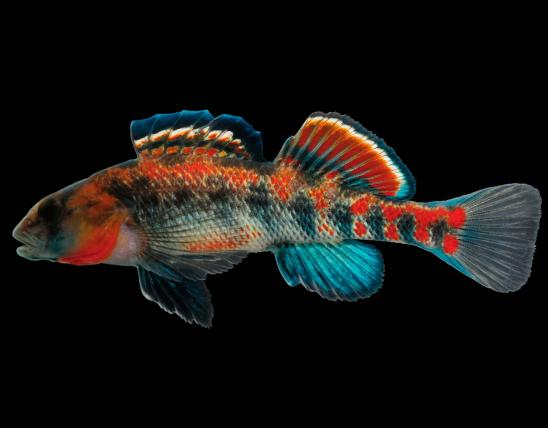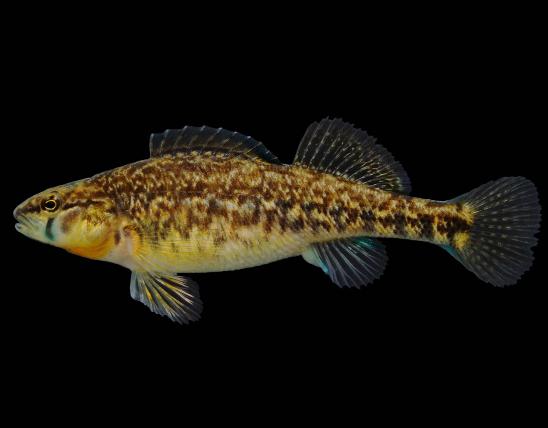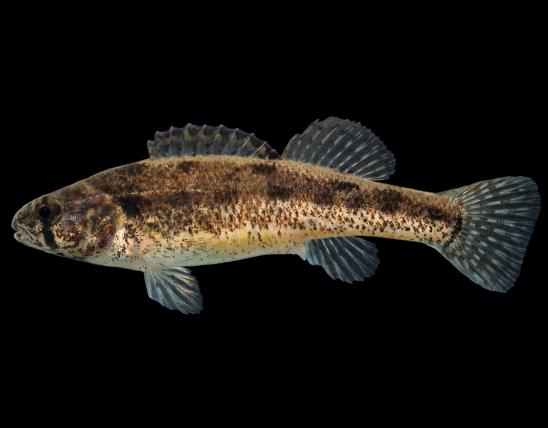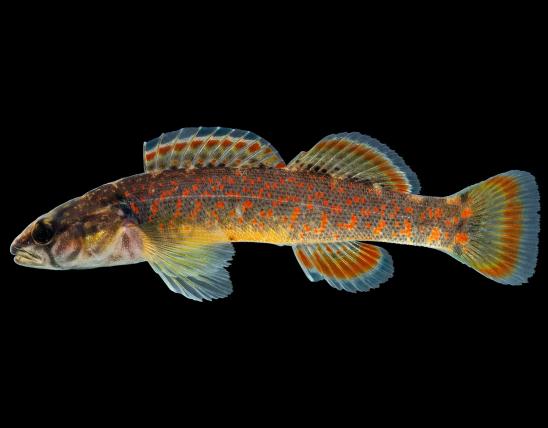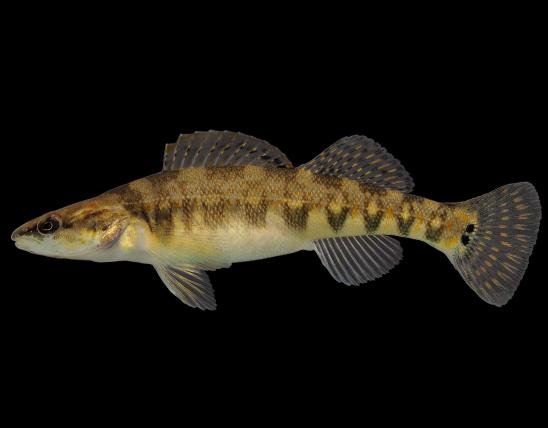
The rainbow darter is a stout-bodied darter with 3 dark crossbars on the back, often interspersed with 1–7 less distinct bars. The back is mottled brown with a series of dark brown crossbars or blotches. The sides are lighter brown with a series of blue-green bars (best developed on the back half of the body). The spinous dorsal is dusky at the base; the soft dorsal and tail fin are faintly banded by brown lines.
Breeding males are brilliantly colored: the body is encircled by 8–11 bright blue-green bars, the spaces between the bars are orange red; the cheek and breast are blue black and the lower surface of the head is orange red; the fins are variously banded and blotched with blue green and orange red.
More key characters: The gill covers are not broadly connected by a membrane across the throat, and the distance from the membrane notch to the front of the lower lip is about equal to the distance from the notch to the front of the pelvic fin base. The midline of the belly lacks enlarged and modified scales. The lateral line is incomplete, usually ending beneath the soft dorsal. Scales in a lengthwise series along the midside are 38–54. Dorsal fins have 9 or 10 spines and 12–14 rays. The anal fin has 2 stiff spines and 6–8 rays.
Similar species: The rainbow darter is similar to the orangethroat darter but has the following differences that distinguish it from the orangethroat: the body is usually deepest beneath the spinous dorsal; the sensory canal encircling the lower half of the eye is continuous (not interrupted beneath the eye); the pectoral fin has 13–15 rays; breeding males, in life, have red color in the anal fin and with red over the entire undersurface of the head.
Adult length: commonly 1¼ to 2¾ inches; maximum of about 3 inches.
The rainbow darter is a common and characteristic darter in the Ozark region of Missouri. It occurs in all the principal stream systems except the Neosho (Spring-Elk).
Habitat and Conservation
The rainbow darter is a common and characteristic darter in the Ozark region of Missouri. Throughout its Missouri range, it is the most abundant darter in most streams of all sizes except for the smallest headwater creeks. It reaches its greatest abundance in medium to large creeks and small rivers.
It prefers rocky and gravelly riffles, runs, and shallow pools of clear, high-gradient streams having mostly silt-free bottoms and permanent, strong flow. It is less tolerant of turbidity and intermittent flow than the related orangethroat darter.
The rainbow darter is strictly a bottom dweller, spending much of its time lurking under the edge of an overhanging rock or foraging over the bottom.
In the Meramec River basin, the rainbow darter is apparently more closely associated with beds of water willow (Justicia) than the orangethroat, greenside, and banded darters. Where the rainbow and orangethroat occur together, the rainbow often predominates in the deeper, swifter water of the central riffle, and the orangethroat is more common along the riffle margin and in smaller and slower side riffles.
Food
Forages over the bottom in search of small invertebrates. Small crustaceans are the first food of the young; larger individuals feed on insect larvae, snails, and crayfish. Midge larvae are a favorite food of adults.
Life Cycle
Spawning occurs from late march into May. Breeding adults congregate in large numbers in riffle sections where swift current and gravelly bottoms provide substrate suitable for egg deposition. The large males (those two years old or older) defend territories, while the yearling males and the females move about randomly over the spawning area. When a female ready to spawn enters the territory of a large male, a pursuit follows, which ends when the female stops and buries the lower half of her body in the gravel. She accomplishes this by driving her head into the gravel and moving forward with vigorous strokes of the tail fin. The male takes a position above her, and the eggs are fertilized and buried in the gravel as both vibrate rapidly. Yearling males are rarely successful in attracting females but often take a position near the spawning pair and also vibrate. Males of this species usually grow larger than females.
Human Connections
Spring and early summer is an ideal time to observe fishes such as rainbow darters. During spawning season, the males possess brilliant colors, and it is easier to watch them because they tend to be in rather shallow water. With some patience, you may be able to watch their interesting spawning activity. Because fish are easily frightened, approach cautiously to avoid transmitting vibrations into the water. Maintain a low profile to avoid being silhouetted against the sky. Consider using binoculars. Wear polarized sunglasses to diminish scattered sun reflections from the water's surface. A day with little wind is ideal, so the surface of the water isn't broken.
Ecosystem Connections
Darters are adapted for life in the swift-flowing sections of clear, rocky streams. As an aid to keep them from being swept downstream, the gas-filled bladder found in most fishes is absent or much reduced in darters. Darters sink immediately to the bottom when they stop swimming, and the press of the current against their enlarged pectoral fins tends to hold them in place. Darters remain much of the time beneath or between rocks and are afforded some measure of protection from the direct action of the current. When moving from place to place, darters proceed by a series of short, quick dashes, and it is this characteristic that has earned them the name "darter."






























